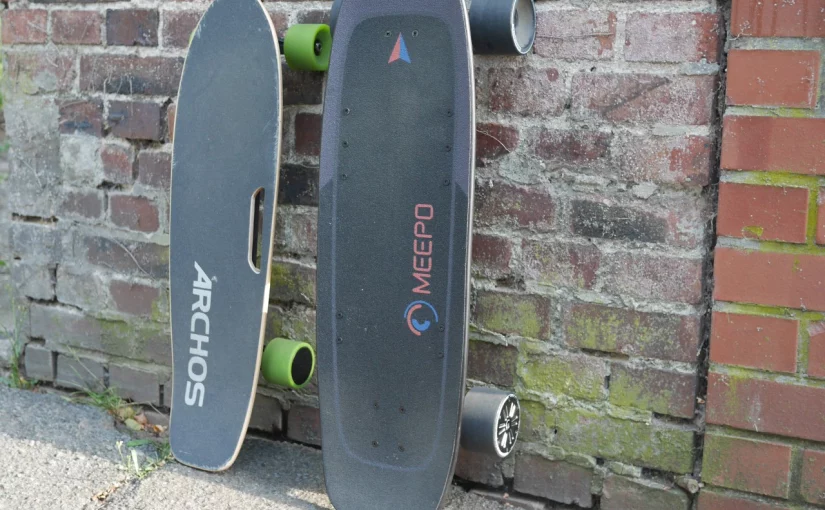Having never skateboarded before, I saw the Archos SK8 electric skateboard for about 80€ at a sale and thought why not give it a try. This got me into this whole electric skateboarding thing.
Table of Contents
Now that I have some more time at home during the summer, I upgraded to the Meepo Mini 2 and after having driven with it more than 100km, I thought I write down my experiences with the two boards and why I should have gotten the Meepo board from the start.
The competitors
The Meepo Mini 2 and the Archos SK8 are not really competing here, which should be clear looking at their price difference. But for completeness, also take a look at the specs of these two boards:
| Meepo Mini 2 | Archos SK8 | |
| Max. speed | 46 km/h | 15 km/h |
| Max. range | 18 km | 7 km |
| Max. Weight | 136 kg | 80 kg |
| Motor | 2 x 540 W | 1 x 150 W |
| Battery | 144 Wh | 50.4 Wh |
| Weight | 7.4 kg | 3.9 kg |
Actually, you can swap the Archos SK8 by any of the unbranded “cheap” Chinese boards that share the same design as the ones sold by Oppikle and Hiriyt.
Here, you might wonder how many Watts you actually need. For this I direct you to the Wikpedia article on bicycle performance that contains some sample calculations (and the formulae) which should roughly hold for electric skateboards as well.
Similarities
Before we dig into the differences, lets first note the similarities aka. the choices I made when picking these specific boards in the first place:
First, both boards are hub-motor driven. I made this choice on purpose, as electric skateboards are not road-legal where I live and hub motors are barely noticeable to the non-practiced eye. This reduces my risk of getting fined for riding one.
However, I would probably generally recommend hub-motors over belt-driven motors nowadays as they require less maintenance (no moving parts), while offering a larger range and allowing pushing the board (belt driven block due to the gear ratio). The latter is especially nice, when you have run out of battery or if you do not want to draw any attention.
When electric skateboards were first introduced by boosted, hub-motors were vastly inferior power-wise but that has changed now.
Next, both boards are of so-called “cruiser-style”. This is a size in between a regular skateboard and a long-board. They share a stiff deck and a kicktail with the former, while the use the wheels of the latter.
At this point I should note that I mainly use the boards for leisure instead of a daily commute. This means that I value versatility of the board over comfort of ride.
Here, having a kicktail is a must and rules out long-boards. It allows doing sharp turn, “wheelies” and you are more agile with the short board.
However, you do notice the quality of the pavement very clearly in your feet and being out of the skating age my ankle did hurt the first couple of rides before it got used to it.
So if you want to commute large distances, you should probably get a long-board with a flexi-deck that can cushion away most of the bumps.
Differences
Both boards are of similar length, however the Meepo Mini 2 is considerable wider and heavier. It also has a larger wheel-base.
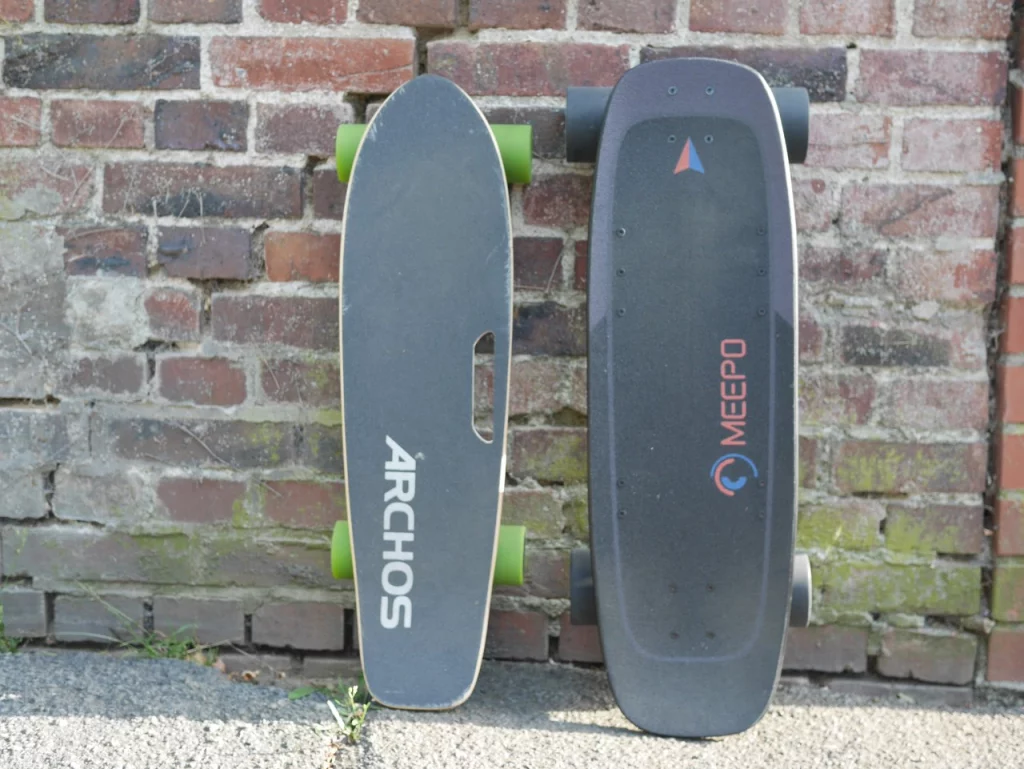
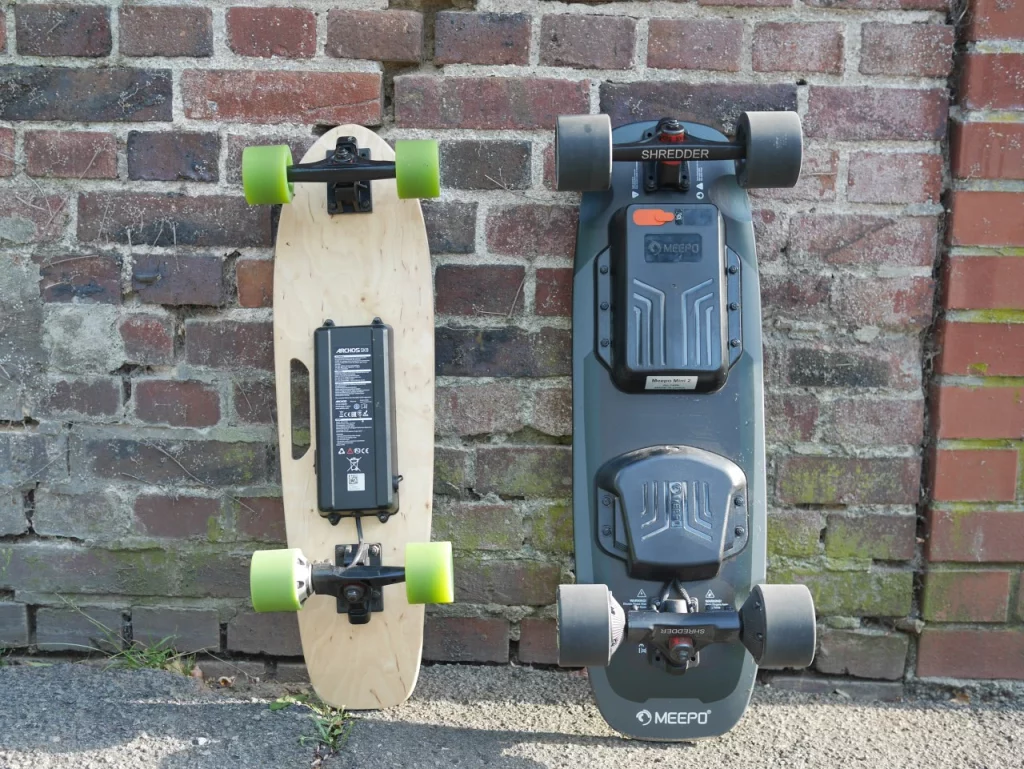
This results in a better grip and you also feel much more stable on the board. Flipping the board around, you see that the SK8 only uses a single-hub motor while the Mini 2 has two and each of them offers more than 3x the power.
If you do not expect the power or if you enable the pro-mode without being one, the Mini 2 can easily throw you off the board when accelerating or breaking. You can tame it though by using the beginner riding mode if you need to learn how to skate first. You can set the modes for acceleration and breaking separately and I would recommend always using at least the pro mode for breaking and learning to deal with it. In case of an emergency you want to be able to stop in time.
Turning to the SK8, the acceleration is.. meh and so are the breaks – in both of the two riding-modes. The difference between them is merely that the top speed is capped at 10km/h in the low-mode.
But I must say that if you are a beginner this is sufficent; if you do not know how to ride being able to get going and to break are your two primary concerns and the SK8 does deliver here. The main drawback of the Archos SK8 is its tiny battery.
Aside: Li-Ion batteries
At this point we should probably briefly discuss Li-Ion battery technology. Mainly, the following two properties:
- As you discharge the battery its Voltage drops, which is related to power (the Watts number) as P = V \cdot I, where I is the current in amps.
So the more you discharge the battery, the fewer Watts you get out of your motors. - A full discharge (down to 0%) of the battery severely reduces its live-span. For maximal durability, you should always keep its charge between 40%-80%. Typically, the displayed range is clipped by the controller to help here.
So where does this leave us with the SK8? I did about 7 rides, fully-discharging the board (you do not want to stop after 10min, right?). And now the second riding-mode is essentially gone: when I try to accelerate the motors draw so much current, that the voltage drops below a critical level and the board turns off. Depending on what state the controller was in, I have to pair the remote again afterwards.
But it also shows in the first mode: while the board initially could get me up a slight slope, it now immediately starts beeping due to critical voltage – again the motors need more voltage then the already worn down battery can give.
Remotes & charging indicators
Having covered the drive train, lets turn to the remotes. Both Archos and Meepo use a similar pistol-grip like design, where you control the motors with the thumb switch.
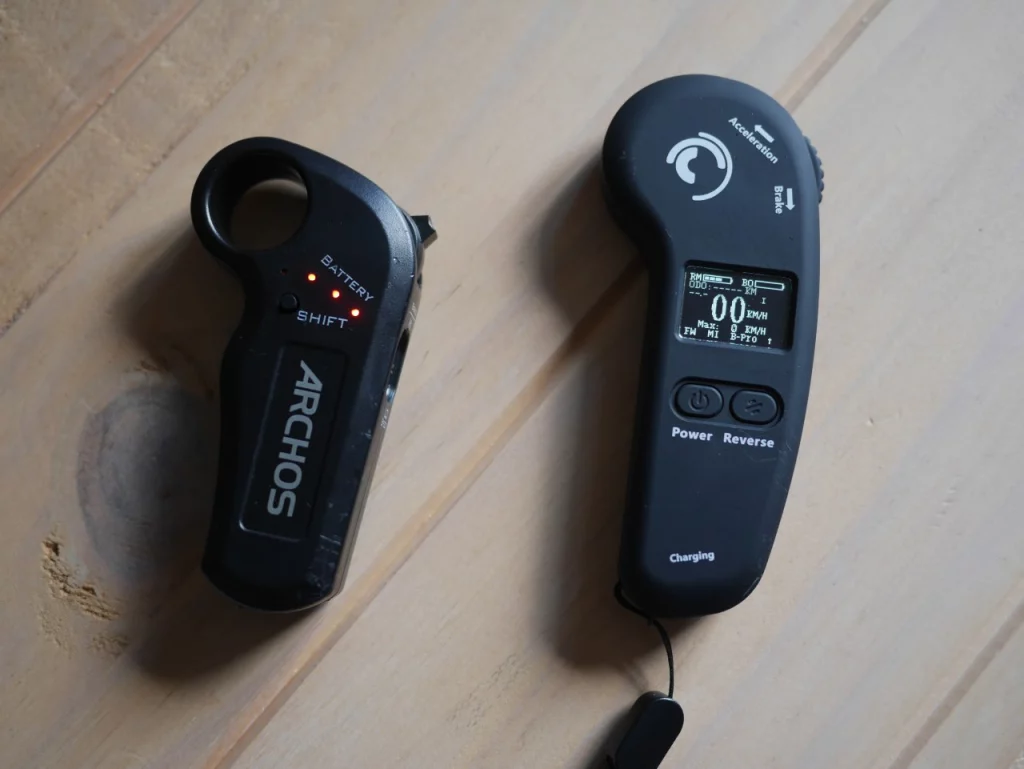
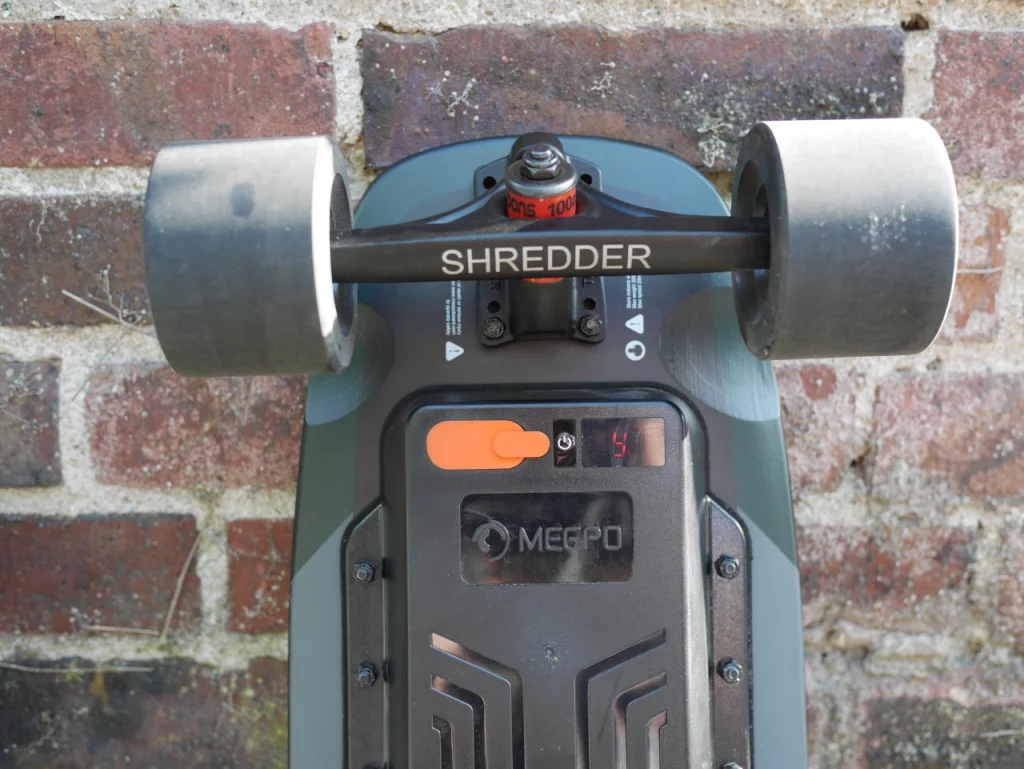
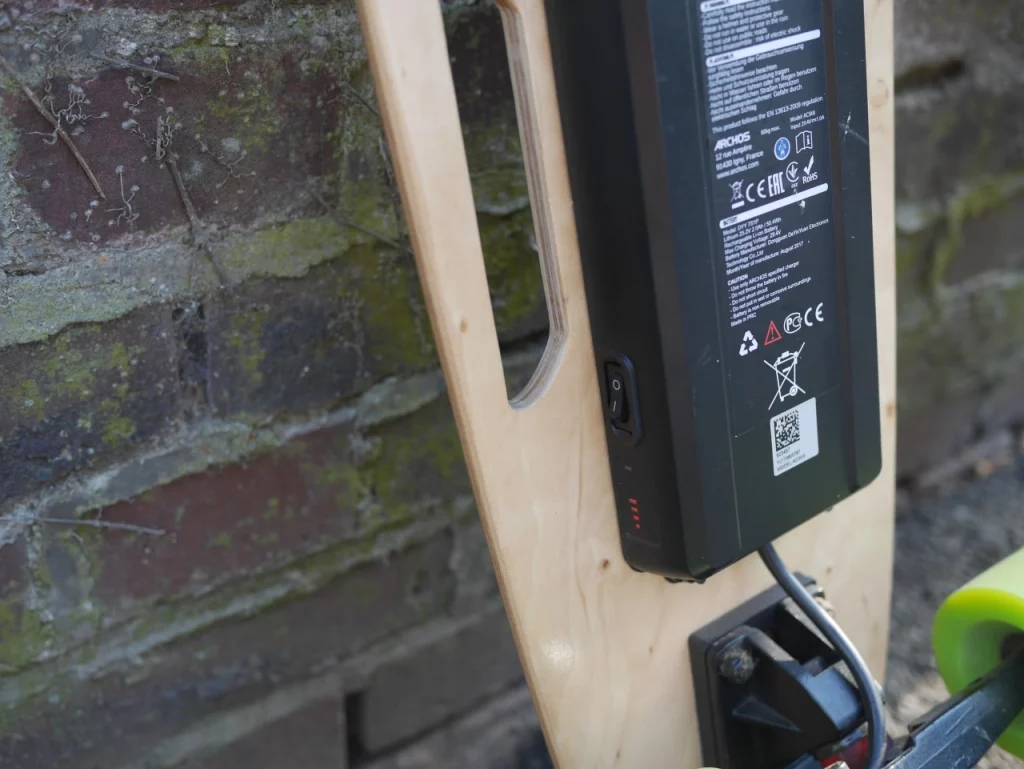
As one would expect, the Meepo remote is more sophisticated and offers detailed telemetry data on a nicely readable LCD display. There you find your current speed, drive mode and board charging level as well as the max. speed of the current ride.
On the Archos remote you only find 4 LEDs. Those are used quite well though: when you turn on the remote, they show the remote charging level. As soon as the board is connected, they indicate the board charging level, which is actually the most important information you need while riding.
Similarly to the remotes, there are only 4 LEDs on the Archos Battery for the charging level, while you find a numeric LED-display on the Meepo board.
An actually noticeable feature on the Meepo Mini 2 is push-to-start; that is, you only have to push the board to turn it on – no need to bend down for flipping a switch.
Verdict
So why do I say you should go straight with the Meepo Mini 2 even as a beginner? On paper the Archos SK8 has everything it takes to be a nice beginner board.
It is really the battery that kills it. With only 5-10 rides it is simply not worth the money, no matter how cheap it is.
Looking at the price difference between the Meepo Mini 2 and the ER version that solely differ in the battery, you grasp that the battery is the crucial part in an electric skateboard. And the Archos SK8 is cheap, precisely because of the bad battery.
With the Meepo Mini 2 on the other hand you get a board that can “grow with you”: as you get more confident you can bump up the riding mode to get more power. Even if you decide that skateboarding is not for you, you can sell the Mini 2 as it will retain lots of its value – in contrast to just producing electric waste with the Archos SK8.
Riding the Meepo Mini 2
The Meepo Mini 2 is specified to go up to 46 km/h. Whether you can go that fast depends on your weight, the wind and the slope (see the Wikipedia link, mentioned above). In case you are fat and/ or there are lots of slopes where you live, you might also consider the ER version of the Mini 2, which comes with doubled battery capacity. As mentioned above this not only means that you can get further, but also that you have more power in the mid-range.
How fast can you go?
Having only previous experience on a Snowboard, I am a rather cautious rider. So far my max. speed (according to the remote) was 30 km/ h which I did uphill – in hope that stopping is easier that way.
Going downhill (only using the motors for breaking), I feel comfortable until around 22 km/ h.
I typically ride for about 30-45 min and the lowest the battery got was 40%, which means it should last for quite some time.
Note, that I do not go straight uphill for 30min and that I usually push to get rolling, as this is where most energy is used.
A suitable helmet
When lifting the board, the remote showed that the ESC only limits the speed at 50 km/h. When riding a skateboard at anything above 10 km/h without a cushion-zone and no nothing, I would highly recommend you to at least wear a helmet.
However, you should consider that a “normal” skate helmet is only specified (EN1078) up to 19.5 km/h impact speed – if you ride faster it does not guarantee protection.
Fortunately, one does not have to resort to heavy motorcycle helmets (ECE2205) as there is a specification (ASTM F1952) for downhill bike helmets, which was designed with speed in mind. It is specified for an impact speed of 22.3 km/h and typically the helmets provide full-face protection.
Recently, even variants for downhill longboarding started to pop-up, which should be even a better fit style-wise.
Addendum: replaced NTA8776 by ASTM F1952 in the last paragraph
